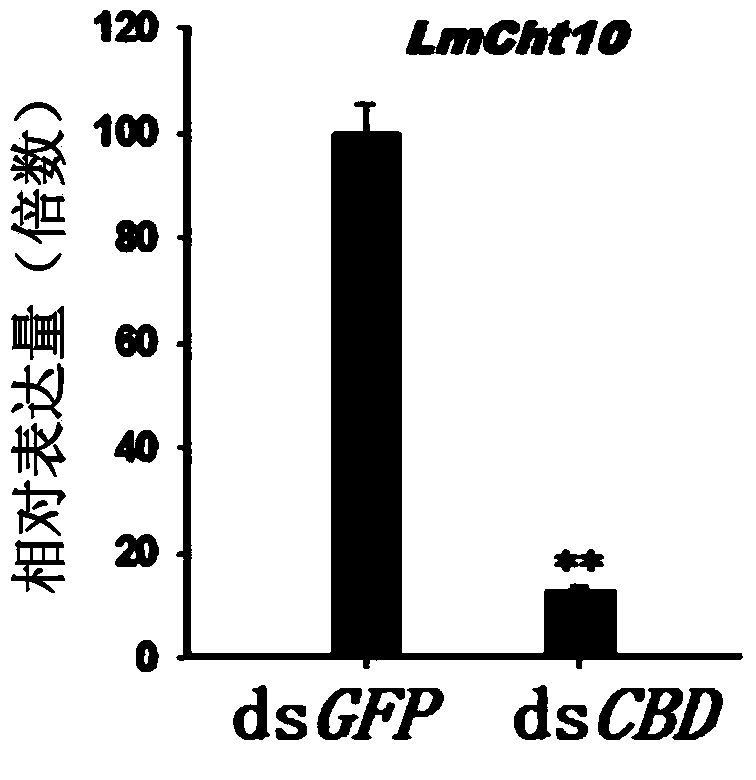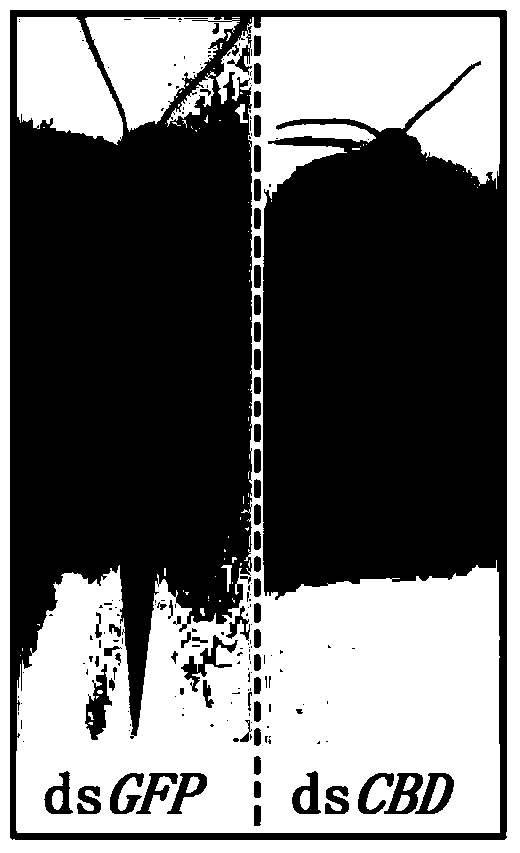Application of type II chitinase gene specificity dsRNA (double strand ribonucleic acid) of insect
A chitinase gene and insect technology, applied in DNA/RNA fragments, applications, genetic engineering, etc., can solve problems such as serious environmental pollution, rising production costs, and increasing pesticide dosages
- Summary
- Abstract
- Description
- Claims
- Application Information
AI Technical Summary
Problems solved by technology
Method used
Image
Examples
Embodiment 1
[0013] Example 1: Obtaining dsRNA specific to migratory locust type II chitinase gene
[0014] 1. Amino acid sequence analysis of migratory locust type Ⅱ chitinase gene
[0015] Based on the transcriptome database of migratory locusts, the bioinformatics method was used to search the type Ⅱ chitinase gene of migratory locusts. The sequence encodes 2964 amino acids. Its functional domain analysis was carried out on the SMART website (http: / / smart.embl-heidelberg.de / ), and its unique chitin binding domain 1 ( figure 1 ).
[0016] 2. Gene-specific dsRNA synthesis of migratory locust type Ⅱ chitinase gene
[0017] 1) Design of dsRNA primers specific to migratory locust type Ⅱ chitinase gene
[0018] Based on the unique chitin-binding domain 1 sequence of migratory locust type II chitinase gene, it was designed using primer premier 5.0 software. Design dsRNA primers, the sequences of which are SEQ ID NO: 2 and SEQ ID NO: 3, respectively. All primers were synthesized by Shangh...
Embodiment 2
[0021] Example 2: Five-instar migratory locusts killed by migratory locust type II chitinase gene-specific dsRNA
[0022] 1. Injection of dsRNA specific for migratory locust type Ⅱ chitinase gene
[0023] 2 μl (6 μg) of dsRNA (dsCBD) of SEQ ID NO: 1 was injected with a 25 μl microsyringe between the second and third abdominal segments of the second-day-old nymphs of the fifth-instar migratory locust, and a total of 30 were injected, with half males and half females. Inject dsGFP at the same volume concentration into the control group. The injected migratory locusts were raised in a constant temperature biochemical incubator at 30°C.
[0024] 2. Gene silencing detection of migratory locust type Ⅱ chitinase
[0025] For detecting the silencing efficiency of the fifth instar dsRNA 24h after injection, the whole worm body was used as the object of RNA extraction, and 3 biological replicates were set up for each group. The total RNA of each sample was extracted and reverse-trans...
Embodiment 3
[0028] Example 3: The specific dsRNA of migratory locust type Ⅱ chitinase gene has no effect on the development of the larvae of Tribulus chinensis.
[0029] 1. Injection of the migratory locust type Ⅱ chitinase gene-specific dsRNA into Orynotus chinensis
[0030] 400ng of dsRNA (dsCBD) of SEQ ID NO: 1 was injected into the larvae of Tribulus chinensis with a microinjector, and a total of 28 larvae were injected, half male and half male. The same mass of dsGFP was injected into the control group. After the injection, the larvae of Tribulus chinensis were reared in a constant temperature biochemical incubator at 30°C.
[0031] 2. Detection of gene silencing of Chitinase type Ⅱ in Tribulus chinensis
[0032] For the detection of silencing efficiency 24 hours after the injection of dsRNA in the larvae of Trichobolus chinensis, the whole larvae were used as the object of RNA extraction, and 3 biological replicates were set up for each group. The total RNA of each sample was ext...
PUM
 Login to View More
Login to View More Abstract
Description
Claims
Application Information
 Login to View More
Login to View More - R&D
- Intellectual Property
- Life Sciences
- Materials
- Tech Scout
- Unparalleled Data Quality
- Higher Quality Content
- 60% Fewer Hallucinations
Browse by: Latest US Patents, China's latest patents, Technical Efficacy Thesaurus, Application Domain, Technology Topic, Popular Technical Reports.
© 2025 PatSnap. All rights reserved.Legal|Privacy policy|Modern Slavery Act Transparency Statement|Sitemap|About US| Contact US: help@patsnap.com



